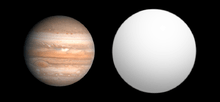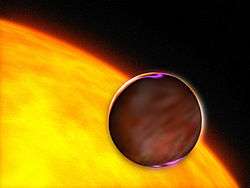XO-1b
XO-1b is an extrasolar planet approximately 536 light-years away.
 Size comparison of XO-1b with Jupiter. | |
| Discovery | |
|---|---|
| Discovered by | Peter McCullough et al.[1] |
| Discovery site | Haleakala Observatory, Hawaii[1] |
| Discovery date | 18 May 2006[2] |
| Transit and Radial velocity[1] | |
| Orbital characteristics | |
| 0.04930+0.00091 −0.00096 AU | |
| Eccentricity | <0.019[3] |
| 3.94150685±0.00000091[4] d | |
| Inclination | 88.8 ± 0.2[4] |
| Semi-amplitude | 116 ± 9[1] |
| Star | XO-1 |
| Physical characteristics | |
Mean radius | 1.21 ± 0.03[4] RJ |
| Mass | 0.913±0.038[3] MJ |
Mean density | 0.64 ± 0.05 g/cm3 (0.0231 ± 0.0018 lb/cu in)[4] |
| 15.8 ± 1.5 m/s2 (51.8 ± 4.9 ft/s2)[5] | |
The planet XO-1b is named Negoiu. The name was selected in the NameExoWorlds campaign by Romania, during the 100th anniversary of the IAU. Negoiu is the second highest peak in Romania.[6][7]
In 2006, the XO Project an international team of professional and amateur astronomers discovered a Jupiter-sized planet, later named XO-1b, orbiting a Sun-like star.[1] The team, led by Peter McCullough of the Space Telescope Science Institute in Baltimore, had four amateur astronomers hailing from North America and Europe.[8] An independent confirmation of the planet was made by the Wide Angle Search for Planets project later that same year.[9]
The XO Project team employed the relatively inexpensive XO Telescope, made from commercial equipment, to search for extrasolar planets.[2] This telescope is on the Hawaiian Island of Maui.[10]
From September 2003 to September 2005, the XO Telescope detected tens of thousands of bright stars. In that time, McCullough's team of amateur astronomers studied a few dozen stars they had previously identified as promising candidates for extrasolar planets. The star XO-1, in particular, was marked as a promising candidate in June 2005. The amateur astronomers observed it from June to July 2005, eventually confirming that a planet-sized object was eclipsing it. McCullough's team then turned to the McDonald Observatory in Texas for information on the object's mass and to confirm it was a planet.[1]
Physical characteristics

As a planet with a mass comparable to that of Jupiter in a close-orbit around its star, this planet falls into the category of hot Jupiters. Like other known transiting hot Jupiters such as HD 209458 b and TrES-1, the low density of XO-1b indicates that this planet is a gas giant composed mainly of hydrogen and helium.
Observations with the NICMOS instrument on board the Hubble Space Telescope detected the presence of water vapor, methane, carbon dioxide, and possibly carbon monoxide in the atmosphere of XO-1b.[11] However, an independent reinvestigation of the same data was unable to reproduce these results.[12] Later studies by the Hubble Space Telescope detected water in the atmosphere of the exoplanet.[13][14]
See also
References
- McCullough, P. R.; et al. (2006). "A Transiting Planet of a Sun-like Star". The Astrophysical Journal. 648 (2): 1228–1238. arXiv:astro-ph/0605414. Bibcode:2006ApJ...648.1228M. doi:10.1086/505651.
- Donna Weaver (18 May 2006). "Astronomers Use Innovative Technique to Find Extrasolar Planet". STScI-2006-22. Space Telescope Science Institute. Retrieved 7 January 2012.
- Bonomo, A. S.; et al. (2017). "The GAPS Programme with HARPS-N at TNG . XIV. Investigating giant planet migration history via improved eccentricity and mass determination for 231 transiting planets". Astronomy and Astrophysics. 602. A107. arXiv:1704.00373. Bibcode:2017A&A...602A.107B. doi:10.1051/0004-6361/201629882.
- Burke, Christopher J.; et al. (2010). "NICMOS Observations of the Transiting Hot Jupiter XO-1b". The Astrophysical Journal. 719 (2): 1796–1806. arXiv:1006.1953. Bibcode:2010ApJ...719.1796B. doi:10.1088/0004-637X/719/2/1796.
- Southworth, John (2010). "Homogeneous studies of transiting extrasolar planets – III. Additional planets and stellar models". Monthly Notices of the Royal Astronomical Society. 408 (3): 1689–1713. arXiv:1006.4443. Bibcode:2010MNRAS.408.1689S. doi:10.1111/j.1365-2966.2010.17231.x.
- "Approved names". NameExoworlds. Retrieved 2 January 2020.
- "International Astronomical Union | IAU". www.iau.org. Retrieved 2 January 2020.
- Robert Naeye (23 May 2006). "Amateurs Help Discover Transiting Exoplanet". sky and telescope. Sky Publishing. Retrieved 8 January 2012.
- Wilson, D. M.; et al. (2006). "SuperWASP Observations of the Transiting Extrasolar Planet XO-1b". The Publications of the Astronomical Society of the Pacific. 118 (847): 1245–1251. arXiv:astro-ph/0607591. Bibcode:2006PASP..118.1245W. doi:10.1086/507957.
- McCullough, P. R.; et al. (2005). "The XO Project: Searching for Transiting Extrasolar Planet Candidates". Publications of the Astronomical Society of the Pacific. 117 (834): 783–795. arXiv:astro-ph/0505560. Bibcode:2005PASP..117..783M. doi:10.1086/432024.
- Tinetti, G.; et al. (2010). "Probing the Terminator Region Atmosphere of the Hot-Jupiter XO-1b with Transmission Spectroscopy". The Astrophysical Journal Letters. 712 (2): L139–L142. arXiv:1002.2434. Bibcode:2010ApJ...712L.139T. doi:10.1088/2041-8205/712/2/L139.
- Gibson, N. P.; et al. (2011). "A new look at NICMOS transmission spectroscopy of HD 189733, GJ-436 and XO-1: no conclusive evidence for molecular features". Monthly Notices of the Royal Astronomical Society. 411 (4): 2199–2213. arXiv:1010.1753. Bibcode:2011MNRAS.411.2199G. doi:10.1111/j.1365-2966.2010.17837.x.
- Staff (3 December 2013). "Hubble Traces Subtle Signals of Water on Hazy Worlds". NASA. Retrieved 4 December 2013.CS1 maint: uses authors parameter (link)
- Deming, Drake; et al. (2013). "Infrared Transmission Spectroscopy of the Exoplanets HD 209458b and XO-1b Using the Wide Field Camera-3 on the Hubble Space Telescope". The Astrophysical Journal. 774 (2). 95. arXiv:1302.1141. Bibcode:2013ApJ...774...95D. doi:10.1088/0004-637X/774/2/95.
External links
![]()
- "Astronomers Catch Planet By Unusual Means". SpaceDaily. 19 May 2006. Retrieved 29 June 2008.
- Ayiomamitis, Anthony (4 June 2009). "Astrophotography by Anthony Ayiomamitis". Retrieved 10 June 2009. (Amateur's observation using Differential Photometry)